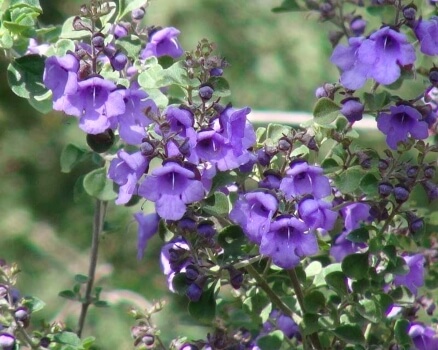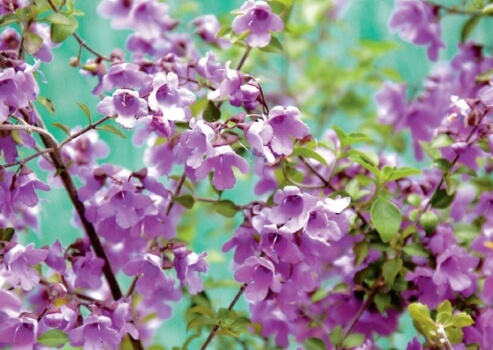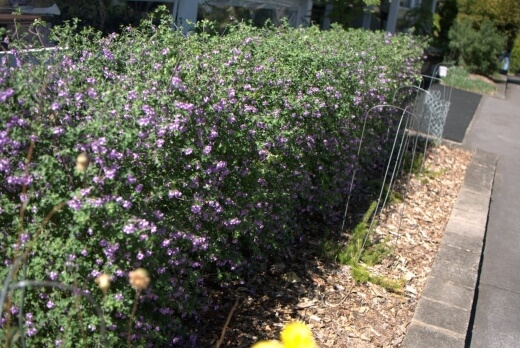Prostanthera rotundifolia or Native Oregano is an erect and compact flowering shrub prized for its ornamental landscaping qualities and its highly aromatic branches. Its beautifully rounded leaves and clusters of purple to mauve flowers can elevate any garden's spectacle, especially throughout spring.
This beloved bush tucker is a type of native mint valued for its medicinal and culinary applications so it’s certainly worth consideration for those who enjoy harvesting from their gardens.
Today, I will explain how you can grow and care for this useful shrub in your garden.
More...

Source: GardensOnline
Family: | Lamiaceae |
|---|---|
Genus: | Prostanthera |
Species: | P. rotundifolia |
Origin: | Australian Native |
Common Names: | Round-Leaf Mint Bush, Native Oregano, Round-Leaved Mint Bush |
Location: | Outdoor |
Type: | Shrub |
Growth: | Up to 2 metres tall, up to 1.5 metres wide |
Sun requirements: | Full sun, part-shade (preferred) |
Foliage Colour: | Green |
Flower Colour: | Mauve |
Flowering: | Summer |
Maintenance level: | Low |
Poisonous for pets: | Non-toxic to cats and dogs |
Introducing Prostanthera rotundifolia
Featuring an attractive bushy habit that’s perfect for filling out gaps and tough spots in the garden, this shrub can also be used in other creative ways depending on your needs.
Enjoy the attractive dark-green foliage of this evergreen shrub all year with brilliant eruptions of mauve to lilac cup-shaped blooms from September to November.
Part of the mint family, Lamiaceae, this species is native to south-eastern Australia where it occurs mostly in the wild temperate regions of South Australia, New South Wales, Victoria and Tasmania.
Botanically labelled Prostanthera rotundifolia, the plant's common names include round-leaf mint bush, native oregano or the round-leaved mint bush.
Considered a fast-growing species, this shrub will typically reach up to 2 metres tall and up to 1.5 metres wide cultivated in residential gardens. It can be grown successfully in containers where its growth will naturally be reduced.
Ideal climate zones are cool, warm temperate and subtropical. Its compact and dense habit makes it a perfect solution for tough spots like edges, gaps, narrow beds or near fences as a border.
Other common uses include:
- Topiary (can be clipped into balls and shapes)
- Feature specimen
- Container gardening
- Edible hedging and screening
- Herb gardening
Native oregano will attract bees, insects and lizards and is considered non-toxic to humans, dogs and cats.
How to Grow Prostanthera rotundifolia

Source: Garden Variety
The shrub is best grown from an established seedling as it will strike with ease and minimal effort in gardens. Healthy seedlings can be purchased from reputable Australian nurseries online or in-store and then transplanted into your garden.


Get Your Free Guide:
Master Growing Australian Natives eBook
A Must Have Complete Guide for Every Australian Garden
Get Your Free Guide:
Master Growing Australian Natives eBook
A Must Have Complete Guide for Every Australian Garden
Alternatively, this species responds well to being propagated using semi-hardwood cuttings.
Propagating Round-Leaf Mint Bush Using Cuttings
- Take healthy semi-hardwood cuttings that are about 7cm to 10cm long. Semi-hardwood cuttings should be woody but still flexible.
- Remove half of the lower leaves from the cuttings then dip the cut ends into some rooting hormone.
- Prepare containers filled with a quality propagating mix then plant the cuttings into the mixture, gently firming the mix around their bases until secure.
- Mist the cuttings well after planting then place them in a warm, sheltered location protected from strong winds.
- Mist the soil regularly to keep it moist.
- Roots should develop within 3 to 4 weeks.
Planting and Growing Conditions for Native Oregano
Prostanthera rotundifolia is best planted around Autumn as it prefers slightly cooler conditions than some of our other native flowering shrubs.
Here are the preferred growing conditions you can aim for to ensure your plant thrives and looks its best throughout the year.
Sunlight and Positioning
While this species can withstand full sun, it does prefer temperate, partly shaded conditions, especially in warmer regions. It will also perform best in a sheltered position that is protected from strong winds.
Soil Needs
Round-leaved mint bush can tolerate different soil types but prefers soils that drain well. It is also suitable for sandy soils. The best practice is to boost soil with some compost and pelletised organic fertiliser before planting and digging in well.
Growing Native Oregano in Pots
- This species will grow well in pots and containers with regular pruning.
- Use a quality potting mix and a container with good drainage.
- Mulch around the base of the shrub with an organic mulch in summer to assist with moisture retention.
- Position in a cool spot in the garden with dappled sunlight.
- Choose the award-winning cultivar Prostanthera rotundifolia ‘Rosea’ for the best container growth.
Native Oregano Quick Gardening Tips
- For hedges or screens, tip prune regularly for bushier growth and to maintain an attractive aesthetic.
- Good drainage is essential for this species so raised garden beds can help ensure this.
- Plants will droop and wilt if exposed to overly dry conditions. Water to repair.
- Overwatering should be avoided as this can lead to root rot and fungal infections.
How to Care for Prostanthera rotundifolia
Once established, this plant can tolerate light frosts and drought. Overall, it is a truly low-maintenance addition to gardens with basic care requirements.

Source: Plant Native
Watering Native Oregano
Young plants will need to be watered regularly until established. Thereafter, water well in summer then occasionally throughout the year. On average, a good weekly watering is a sufficient starting point.
Pruning
To maintain a healthy bushy growth habit, prune away one-third of its growth annually after flowering using a sharpened pair of pruning shears.
Fertiliser and Mulching Needs
After flowering in spring to early summer, feed your shrub with an organic fertiliser or native plant food and water in well. Throughout the growing season in summer, mulch with an organic mulch to help retain adequate soil moisture.
Pests and Diseases
Prostanthera rotundifolia is a mostly pest and disease-resistant species. Red spider mites can become a problem in certain conditions.
Refer to our guide on how to get rid of spider mites for everything you’ll need to know.
Native Oregano Bush Tucker Guide
Prostanthera rotundifolia is a type of native mint and a highly aromatic herb that is the perfect native substitute for common oregano.
Its flavour is not as sweet as oregano but it does feature more complex earthy notes with a citric tang. Many say it tastes like a fantastic combination of mint and oregano.
Traditionally, it was used as a medicinal herb for treating headaches, colds and fever. Nowadays, it has many delicious culinary applications.
The leaves and softer stems of this shrub are the edible parts.
Harvesting Native Oregano
- Leaves can be picked and harvested directly from the plant as needed throughout the year.
- Simply pluck the leaves off the bush or prune whole stalks at a time.
- As a safety precaution, delay harvests for a few days after fertilising and be sure to rinse before consumption.
- Should you use any pest control products, be sure to read any health and safety information before eating the plant.
How to Use Prostanthera rotundifolia
- Leaves can be used fresh after rinsing or chopped and dried for use later on.
- The flavour and aroma of picked leaves will fade over time so be sure to use them when they are still at their best.
- This native herb has very diverse culinary uses. It can be used to flavour sauces, pasta, chicken and meat dishes and even makes for a lovely topping on pizza.
- Alternatively, it makes for an excellent flavourful addition to salads, savoury dishes like stews and even marinades.
- The dried leaves can also be steeped in hot water to make a fragrant herbal tea.
- Lastly, this bush tucker herb can be used as an aromatic garnish in cocktails, gins and tonics, cordials and lemonade.
Prostanthera rotundifolia Frequently Asked Questions

Source: Mallee Design
What is Prostanthera rotundifolia used for?
This native Australian herb is commonly used in domestic kitchens to flavour fresh salads, savoury meat dishes, and sauces or can be steeped in hot water to make a herbal tisane. The leaves can be used fresh or chopped and dried.
How do you prune Australian mint bush?
These plants respond well to light pruning like tip pruning. Trim and prune immediately after flowering to maintain plant vigour and a dense growth habit.
What are the health benefits of native oregano?
Similar to common oregano, native oregano has anti-inflammatory, antioxidant and antimicrobial properties. Traditionally, the herb was used to treat headaches, colds and fever.
What are the best growing conditions for Prostanthera?
This species prefers temperate conditions with good moisture and part shade. Water generously in summer and be sure to plant in freely draining soil.
How long does Prostanthera rotundifolia take to establish?
These Aussie shrubs can take between 10 and 20 years to reach full maturity in gardens.
Can I substitute common oregano for native oregano?
Native oregano does have its own flavour profile versus normal oregano. In some savoury dishes or sauces, its earthier notes may be a welcome change for those who enjoy bushfood.
Is the Australian mint bush an evergreen?
Yes, these plants feature attractive emerald evergreen foliage with a bushy growth habit, perfect for many useful landscaping applications in gardens.
Check out some of our other bush tuckers below:
Enjoy Prolific Purple Blooms and Minty Herbage with Prostanthera rotundifolia
A truly superb native shrub with excellent bush tucker qualities, Prostanthera rotundifolia or native oregano is a perfect pick for those looking for an ornamental shrub or those who want to utilise the plant’s useful foliage in the kitchen.
With its attractive and fragrant evergreen foliage, masses of mauve blooms in spring, and minty leaves, there’s a lot to love about this species. Start growing your very own Prostanthera rotundifolia shrub to take advantage of the many wonderful qualities this Australian native offers.
Published on April 27, 2023 by Nathan Schwartz
Last Updated on March 27, 2024




